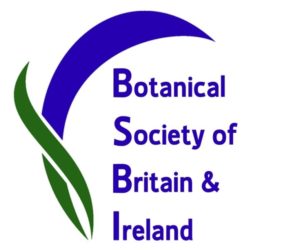Kirkcudbrightshire Botany Group, Grey Mare’s Tail and Burn, Talnotry 29/03/2019
Four sites for Wilson’s Filmy Fern Hymenophyllum wilsonii are known for this burn from around the 1980s and the intention was to re-locate the populations. 10 of us met at the base of the waterfall just off the main road in glorious sunshine and began by exploring the falls and surrounding damp rocks (site 1). No luck here, so we walked sharply uphill to the second waterfall and its plunge pool. Still no luck, although by then we had recorded a number of either ancient woodland species, such as Pignut Conopodium majus, Yellow Pimpernel Lysimachia nemorum and Bugle Ajuga reptans, the latter recognisable by its glossy dark green upper surface and purplish under surface to the leaf. Around these areas we’d found Hard Shield-fern Polystichum aculeatum with its distinctive acute tipped and sharply serrated pinnules, dark green colour and stiff frond, on rock faces.
We’d also found a fair number of damp ground-loving species which indicated some nutrient enrichment alongside the burn – Marsh Valerian Valeriana officinalis, Marsh Hawk’s-beard Crepis paludosa and Water Avens Geum rivale.
There was also the usual woodland suspects such as Bluebell Hyacinthoides scripta, Honeysuckle Lonicera periclymenum and Opposite-leaved Golden Saxifrage Chrysosplenium oppositifolium – and of course Bracken Pteridium aquilinum and Hard Fern Blechnum spicant with both sterile and last year’s fertile fronds intact.
We’d also walked through some very acid ground and marsh with Purple Moor-grass Molinia caerulea, Cross-leaved Heath Erica tetralix and various rushes (Juncus spp.), with Lesser Spearwort Ranunculus flammula in the wet runnels. Bog Myrtle Myrica gale, of sweet, almost liquorice scent, about to open its flowers.
Lunch just below the third site, another waterfall, in glorious sunshine, and this proved successful for the Filmy Fern. Three separate clumps in and around the north-facing wet rocks. Notice the slightly toothed edge of the fronds and the nerves that extend right to the end of each tip. And the scale!
As lunch finished, the weather changed dramatically with a distinct and obvious drop in the temperature and a rising cold wind. Leaving out the fourth fern site we walked towards Black Loch, recording the various species usually associated with forest roads and cleared areas for quarrying or timber stacking. Plenty of common species, but also the now all-too-common invader Slender Rush Juncus tenuis, recognisable by its thin wiry leaves and fruiting spike from last season, with the bract extending way beyond the fruiting bodies. Also Heath Rush J. squarrosus with its plump rounded fruits on a stiff stalk, Wavy Bitter-cress Cardamine flexuosa with its 6 stamens, nearby the four-stamened Hairy Bitter-cress C. hirsuta, the curved leafed Pill Sedge Carex pilulifera, and rather surprisingly Western Gorse Ulex gallii – short bush with yellowy-green leaves and less stiff spines as opposed to the dark green, stiffly-spined, and very sharp, Common Gorse U. europaeus. And, of course, Coltsfoot Tussilago farfara in flower.
Black Loch was a bit disappointing with little in the way of obvious water plants. A bit of Bottle Sedge Carex rostrata from last season, drifts of a pondweed which turned out to be Broad-leaved Pondweed Potamogeton natans with its very long stipules and drifts of Bulbous Rush Juncus bulbosus. A small pool at the end of the loch turned up Bog Pondweed P. polygonifolius, but the best find here was Water Lobelia Lobelia dortmanna recognisable by the two distinct channels in the cross-section of the leaf. The cold wind had by now persuaded us to return to the cars and an earlier than usual finish. I forgot to mention that scattered along the burn we’d found Himalayan Cotoneaster Cotoneaster simonsii, an all-too-frequently planted (by Forestry Commission) species which soon spreads due to berry-eating birds.
The statistics – between us we’d recorded over 100 species and one population of that scarce fern. Thanks to all who helped find all these.
David Hawker
BSBI county recorder for Kirkcudbrightshire VC73

